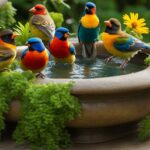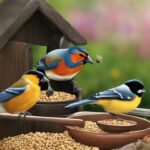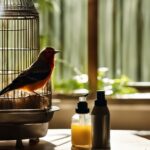Welcome to the exciting world of bird flight training! In this article, I will guide you through the basics of training your pet bird to fly outdoors. Mastering these fundamental skills will ensure a safe and successful flight experience for both you and your feathered friend.
Before embarking on outdoor flight training, it is essential to build a strong foundation. Begin by honing your basic training skills, such as clicker training, which will help establish clear communication between you and your bird. Starting flight training with a fledgling bird, at its natural age, is highly recommended for optimal results.
Creating a bond with your bird is crucial for successful flight training. Spend quality time together, allowing your bird to develop its flight skills indoors before venturing outdoors. This will help your bird feel comfortable and confident in its abilities.
In the sections that follow, we will explore the benefits of flight training for birds, the importance of choosing the right time and bird, indoor flight training exercises, creating a comfortable outdoor flying area, developing a bond with your bird, setting up a training routine, skills development through target training, reinforcing positive behaviors, socializing your bird, gradual conditioning and physical exercise, choosing the right reinforcements, developing recall flying skills, practice and fluency in flight training, and safety considerations and supervision.
Key Takeaways:
- Master basic training skills, such as clicker training, before attempting outdoor flight training.
- Start flight training with a fledgling bird for faster and safer results.
- Build a strong bond with your bird and allow it to develop flight skills indoors.
- Create a comfortable and familiar outdoor flying area for your bird.
- Consistency, patience, and positive reinforcement are crucial elements in flight training.
Benefits of Flight Training for Birds
Flight training is highly beneficial for pet birds. It helps maintain their physical health as flight is a natural and necessary behavior for birds. Additionally, flight training strengthens the bond between the bird and its owner, promoting a healthier and more interactive relationship. Learning and practicing flight skills also stimulate the bird’s mental and cognitive abilities, making it an enriching experience for both the bird and the owner.
There are several key benefits of flight training for birds:
- Physical Health: Flight training allows birds to exercise their wings and maintain strong muscles, promoting overall physical well-being.
- Bonding and Relationship Building: Through flight training, birds and their owners can build a stronger bond and trust, leading to a more fulfilling and interactive relationship.
- Mental Stimulation: Learning and practicing flight skills challenges the bird’s cognitive abilities, keeping them mentally stimulated and engaged.
- Enrichment and Natural Behavior: Flight is a natural behavior for birds, and flight training allows them to fulfill their instinctual need to soar and explore their environment.
Flight training provides a holistic approach to bird care, addressing their physical, mental, and emotional well-being. It allows pet birds to live a more fulfilling and natural life, while also deepening the bond between them and their owners. By incorporating flight training into their routine, bird owners can provide their feathered companions with the opportunity to thrive and experience the joys of flying.
Bird Flying Techniques:
Flight training involves teaching birds a variety of flying techniques to help them navigate their surroundings with confidence and skill. These techniques may include:
- Takeoff and Landing: Birds learn to take off from a stationary position and land safely and smoothly, improving their flight control.
- Turning and Maneuvering: Birds develop the ability to make precise turns and maneuvers while in flight, enhancing their agility and dexterity.
- Ascending and Descending: Birds learn how to navigate different altitudes, mastering the art of ascending and descending during flight.
- Flying in Circles and Patterns: Birds practice flying in circles and specific patterns, improving their flight coordination and control.
By mastering these flying techniques, birds become more confident and capable flyers, allowing them to explore their surroundings safely and enjoy the freedom of flight.

| Flyin Technique | Description |
|---|---|
| Takeoff and Landing | Teaching birds how to take off from a stationary position and land safely and smoothly. |
| Turning and Maneuvering | Helping birds develop the ability to make precise turns and maneuvers while in flight. |
| Ascending and Descending | Training birds to navigate different altitudes and master the art of ascending and descending during flight. |
| Flying in Circles and Patterns | Practicing flying in circles and specific patterns to improve flight coordination and control. |
Bird Flight Training Basics: Learning How to Soar!
When it comes to bird flight training, choosing the right time and bird is crucial for success. Starting flight training with a baby bird that is partially feathered and still being hand-fed allows for a gradual adjustment period and the development of a strong bond with the trainer. This age provides the highest chances of success for both the trainer and the trainee.
It is important to select a bird that offers the least degree of difficulty to increase the chances of successful flight training. Certain bird species, such as budgies or cockatiels, are often recommended for beginners due to their smaller size and more manageable flight skills. However, each bird is unique, and it is important to consider factors such as temperament, agility, and willingness to learn when choosing the right bird for flight training.
Choosing the Right Time and Bird for Flight Training
Age plays a significant role in bird flight training. Starting flight training with a baby bird that is at the natural age of fledgling allows for a smoother transition into outdoor flight training. At this age, the bird is naturally inclined to stay close to its caregiver and has a higher motivation to learn and explore. It is essential to build a strong bond with the bird during this period to establish trust and facilitate the training process.
By selecting the right time and bird for flight training, beginners can lay a solid foundation for successful training. The gradual adjustment period and bond development with a baby bird, along with the choice of a suitable bird species, increase the chances of a positive and rewarding flight training experience.
| Bird Species | Suitability for Beginners |
|---|---|
| Budgies (Parakeets) | Highly suitable due to their small size and manageable flight skills |
| Cockatiels | Recommended for beginners due to their friendly nature and adaptability |
| Lovebirds | Can be suitable for beginners with proper training and socialization |
By considering the age and species of the bird, beginners can set themselves up for success in bird flight training. It is important to remember that each bird is unique, and patience, consistency, and positive reinforcement are key elements in the training process.
Bird Flight Training Basics: Indoor Flight Training Exercises
Indoor flight training exercises play a crucial role in developing a bird’s flying skills before venturing outdoors. These exercises are designed to gradually increase the complexity and distance of flights within a controlled indoor environment. By following a structured training routine, birds can enhance their flight capabilities and improve their overall flying skills.
Flight Training Exercises
1. Short Flights: Start with short flights from the bird’s cage or perch to desired locations within the training area. This helps the bird become familiar with the act of flying and build confidence in its flight abilities.
2. Exploratory Flights: Progress to exploratory flights that allow the bird to check out its surroundings and navigate obstacles. This helps develop the bird’s maneuvering skills and spatial awareness.
3. Target Training: Incorporate target training into the flight exercises. Teach the bird to fly to a designated target, such as a stick or perch, by using positive reinforcement. This helps improve the bird’s accuracy and precision during flights.
4. Recall Cues: Train the bird to fly back to the trainer on cue. This is important for ensuring the bird’s safety during outdoor flights. Use recall cues, such as a specific sound or word, and reinforce the behavior with rewards. Gradually increase the distance and difficulty of the recalls to challenge the bird’s flying skills.
By incorporating these indoor flight training exercises into the overall training routine, bird owners can help their feathered friends develop strong flying skills and prepare them for successful outdoor flight training.

Creating a Comfortable Outdoor Flying Area
Before attempting outdoor flight training, it is important to create a comfortable and familiar environment for your bird. By placing the bird’s cage in the intended outdoor flying area, you allow the bird to become acquainted with the surroundings and reduce any potential anxiety or fear. To further ensure a smooth transition to outdoor flights, it is essential to minimize new or unfamiliar stimuli in the outdoor area. This helps reduce distractions and allows your bird to focus on the training sessions.
Creating a comfortable outdoor flying area also involves considering the safety of your bird. Ensure that the area is free from any potential hazards, such as toxic plants, predators, or electrical wires. It is crucial to provide a secure and enclosed space, such as a screened-in porch or aviary, to prevent your bird from escaping or encountering any danger. Additionally, assess the weather conditions before each outdoor training session to ensure that it is suitable for your bird to fly safely.
“By acclimating your bird to the outdoor environment and providing a secure and comfortable flying area, you can create an optimal setting for effective flight training.”
Gradually introducing your bird to the outdoor environment is key. Begin by taking your bird outside in a carrier or on a harness to familiarize it with different outdoor settings. This exposure allows your bird to adapt and feel more comfortable in new environments. Consider going for short walks with your bird or providing supervised outdoor experiences to promote confidence and reduce any apprehension your bird may have about outdoor spaces.
| Benefits of Creating a Comfortable Outdoor Flying Area | Considerations for Outdoor Flying Area |
|---|---|
|
|
By acclimating your bird to the outdoor environment and providing a secure and comfortable flying area, you can create an optimal setting for effective flight training. Remember to always prioritize the safety and well-being of your bird throughout the training process.
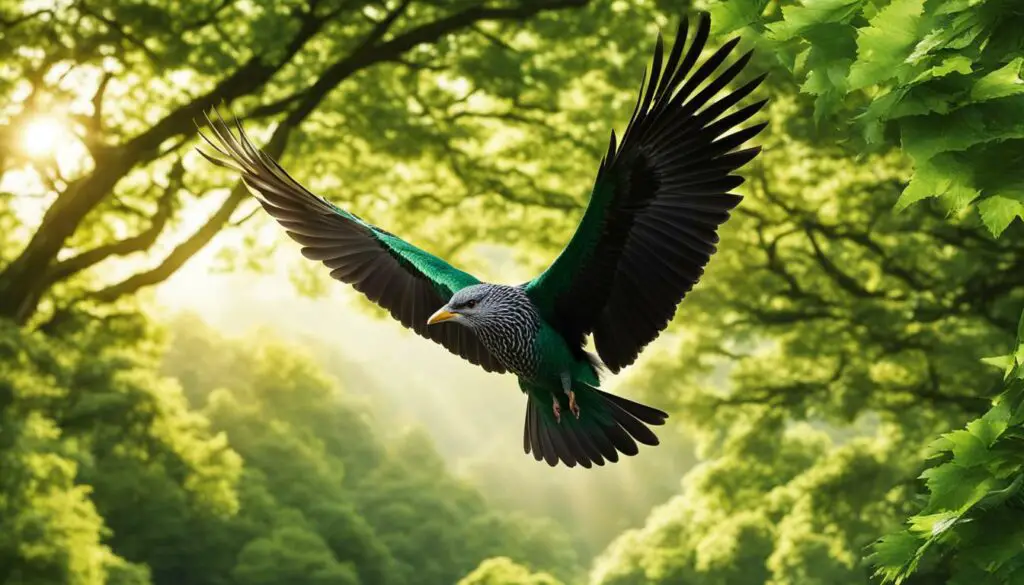
Developing a Bond with the Bird
Establishing a strong bond between the trainer and the bird is central to successful flight training. A close bond promotes trust and cooperation, making the training process more enjoyable and effective. Starting flight training with a baby bird at the age of fledgling allows for the development of a strong bond, as the bird is naturally inclined to stay close to its caregiver during this age. Building a close bond from the beginning enhances the overall training experience and the bird’s willingness to learn.
There are several ways to develop a bond with a bird. Spending quality time with the bird outside of training sessions can help build trust and familiarity. Interacting with the bird in a gentle and positive manner, such as talking softly or offering treats, can also strengthen the bond. It is important to be patient and give the bird time to adjust and feel comfortable in its surroundings. By showing the bird love, respect, and consistency, a strong bond can be formed, laying the foundation for successful flight training.

Building Trust through Positive Reinforcement
Positive reinforcement plays a crucial role in building and maintaining a strong bond with the bird. Rewarding the bird for desired behaviors, such as following cues or engaging in training exercises, helps create a positive association with the trainer. Offering favorite treats, praise, or access to toys can serve as effective rewards. It is important to be consistent in rewarding the bird for its efforts and progress, as this helps reinforce the desired behaviors and strengthens the bond.
| Benefits of Bonding with the Bird: |
|---|
| Enhanced trust and cooperation |
| Improved responsiveness to training |
| Increased enjoyment for both the bird and the trainer |
| Establishment of a strong foundation for future training endeavors |
“Building a strong bond with a bird is like laying a solid foundation for a house. Without it, the training process may crumble, but with it, the possibilities are endless.”
Remember, developing a bond with the bird takes time and patience. Each bird is unique and may require different approaches. By investing in the relationship and consistently demonstrating care and respect, the bond will grow stronger, leading to a more successful and fulfilling flight training experience.
Bird Training Tips: Setting up a Training Routine
Creating a structured training routine is essential for successful bird flight training. By establishing a consistent schedule, both the trainer and the bird can develop a rhythm and make progress in their training journey. Here are some bird training tips to help you set up an effective training routine:
- Start with short training sessions: When beginning flight training, it’s important to keep the sessions short and focused. Birds have limited attention spans, especially when they are still learning, so aim for sessions that last no longer than 10-15 minutes.
- Be consistent: Consistency is key in bird training. Set a regular training schedule and stick to it. Birds thrive on routine, and by having consistent training sessions at the same time each day, you create a predictable environment that helps them feel secure and comfortable.
- Incorporate flight exercises: During the training routine, dedicate time to practicing flight exercises indoors. Start with simple flights from the cage to desired locations and gradually increase the complexity of the flights. This helps the bird develop its flight skills and build confidence before venturing outdoors.
- Focus on positive reinforcement: Positive reinforcement is an essential component of bird training. Use rewards, such as treats or praise, to reinforce desired behaviors. By rewarding the bird when it exhibits the correct flight behavior, you encourage it to repeat the behavior in the future.
Remember, each bird is unique, and it’s important to tailor the training routine to suit their individual needs and abilities. Observe your bird’s progress, make adjustments as necessary, and always prioritize their safety and well-being.

Tips for Successful Training Sessions
Here are a few additional tips to help you make the most of your bird training sessions:
- Choose a quiet and distraction-free environment for training sessions. This helps the bird focus and minimizes potential disturbances.
- Break down training goals into small, achievable steps. Gradual progress leads to success and builds the bird’s confidence.
- Keep training sessions fun and engaging. Incorporate toys, games, and interactive exercises to make the training experience enjoyable for both you and your bird.
- Be patient and understanding. Birds learn at their own pace, so avoid rushing or forcing them to perform beyond their capabilities.
By following these bird training tips and setting up a consistent training routine, you can help your feathered friend develop their flight skills and strengthen the bond between you. Remember, training is a journey, and with time, patience, and dedication, you and your bird can soar to new heights!
Bird Training Tips: Enhancing Flight Skills Through Target Training
Target training is a valuable technique for developing a bird’s flight skills. By teaching the bird to touch the end of a target stick, we can gradually progress to more complex tasks, ultimately enhancing the bird’s flight skills and control.
One of the first steps in target training is introducing the bird to the target stick. This can be done by holding the stick near the bird’s beak and rewarding it with a treat or praise when it touches the stick. With repetition and positive reinforcement, the bird learns to associate the target stick with a reward, making it more likely to engage in the desired behavior.
Once the bird is comfortable touching the target stick, we can gradually increase the difficulty of the exercises. For example, we can place the target stick in different locations around the room and encourage the bird to fly to each target. This helps the bird develop precision, agility, and coordination, as it learns to navigate different flight paths and land accurately on the target stick.
| Benefits of Target Training for Birds’ Flight Skills | Examples of Target Training Exercises |
|---|---|
| 1. Develops precision and accuracy in flight | 1. Placing targets at different heights and distances to encourage the bird to fly to specific locations |
| 2. Enhances agility and maneuverability | 2. Creating obstacles for the bird to fly around or through, such as hoops or tunnels |
| 3. Improves coordination and flight control | 3. Setting up a sequence of targets for the bird to navigate, requiring precise flight maneuvers |
Target training not only helps develop a bird’s flight skills but also provides mental stimulation and enrichment. It engages the bird’s cognitive abilities as it learns to problem-solve and adapt to different training scenarios. As trainers, we can customize target training exercises to suit the bird’s individual needs and abilities, ensuring a challenging yet achievable training experience.
Incorporating target training into a bird’s flight training routine can greatly enhance the bird’s overall flight capabilities and control. By gradually increasing the difficulty and complexity of the exercises, the bird builds confidence, agility, and precision in flight, making it a more proficient flyer.

Maximizing Flight Skills Through Target Training
Target training is a powerful tool for enhancing a bird’s flight skills. By introducing the bird to the target stick and gradually increasing the difficulty of the exercises, we can help the bird develop precision, agility, and coordination in flight. Target training not only improves the bird’s flight capabilities but also provides mental stimulation and enrichment. By incorporating target training into a bird’s flight training routine, we can maximize the bird’s flight skills and create a rewarding and engaging training experience.
Bird Training Tips: Reinforcing Positive Behaviors
When it comes to bird flight training methods, reinforcing positive behaviors is essential for success. By rewarding desired behaviors, we can encourage birds to repeat them and make the training process more effective. There are several ways to reinforce positive behaviors during flight training.
“Rewarding the bird for desired behaviors helps reinforce those behaviors and encourages the bird to repeat them.”
One common method is using food treats as rewards. Birds are often motivated by tasty treats, so using their favorite snacks can be a powerful incentive. It’s important to choose treats that are healthy and appealing to the bird. Additionally, verbal praise and physical affection are also effective forms of reinforcement. Birds thrive on social interaction, so acknowledging their efforts with kind words and gentle petting can go a long way in reinforcing positive behaviors.
Another method of reinforcement is using favorite objects or toys. Birds have individual preferences, so identifying the toys or objects they enjoy the most can be a great way to reward them. Whether it’s a shiny bell or a colorful chew toy, incorporating these favorite items into the training sessions can further motivate the bird and strengthen the association between the desired behavior and the reward.
| Reinforcement Methods | Examples |
|---|---|
| Food Treats | Healthy fruit slices, seeds, or specially formulated bird treats |
| Praise and Affection | Verbal praise, petting, gentle scratches |
| Favorite Objects or Toys | Shiny bells, colorful chew toys, puzzle toys |
It’s important to establish a clear association between the desired behavior and the reward. Timing is crucial – the reward should be given immediately after the bird performs the desired behavior to reinforce the connection. Consistency is also key – consistently rewarding desired behaviors helps the bird understand the purpose of the training and encourages them to perform the behavior consistently.
In conclusion, when it comes to bird training tips, reinforcing positive behaviors is an essential aspect of flight training. By using food treats, praise, favorite objects, and toys as rewards, we can motivate birds to repeat desired behaviors and make the training process more enjoyable and effective. Remember to establish clear associations between the desired behavior and the reward, and to be consistent in your reinforcement. With these strategies, you can help your bird develop excellent flight skills and enjoy the freedom of flight!
Bird Training Tips: Socializing Your Bird
When it comes to bird flight training, socializing your bird is an important aspect that should not be overlooked. Socializing your bird involves exposing it to various environments, people, and places, and helping it become comfortable in different settings. This process helps your bird become more adaptable and confident, which are crucial for successful flight training.
There are several ways to socialize your bird. Taking your bird outside in carriers or going for walks in bird-safe areas can help it become familiar with outdoor environments. Additionally, introducing your bird to different people and allowing them to interact with it can help it become comfortable around strangers.
Supervised outdoor experiences are also beneficial for socializing your bird. These experiences can include allowing your bird to explore outdoor aviaries or flying in secure outdoor spaces. By gradually exposing your bird to new stimuli and environments, you can help it develop a sense of confidence and adaptability, which are essential for safe and successful flight training.
Overall, socializing your bird is an important aspect of bird flight training. By providing your bird with varied and positive experiences, you can help it become a well-rounded and adaptable companion.

Table: Benefits of Socializing Your Bird
| Benefits | Description |
|---|---|
| Adaptability | Socializing helps your bird become comfortable in different environments and adapt to new stimuli. |
| Confidence | By exposing your bird to various situations, it can gain confidence and feel more secure in unfamiliar settings. |
| Reduced fear and anxiety | Socializing helps your bird overcome fear and anxiety by gradually introducing it to new people, places, and experiences. |
| Improved behavior | A well-socialized bird is less likely to exhibit negative behaviors and can develop better social skills. |
| Enhanced training success | Socialization lays the foundation for successful flight training by fostering trust, cooperation, and a positive relationship between you and your bird. |
Bird Flight Training Basics: Gradual Conditioning and Physical Exercise
One of the fundamental aspects of bird flight training is gradual conditioning and physical exercise. This process is especially important for birds that have had their wing feathers trimmed or have limited flight experience. By starting with short flights and gradually increasing the distance and duration, we can help improve the bird’s physical condition and stamina, enabling them to develop essential flight skills.
During the gradual conditioning phase, birds learn important maneuvering techniques, such as turning, flying up, flying down, and landing. These skills are crucial for their safety and overall flight capabilities. Providing opportunities for physical exercise through flight training not only strengthens their muscles but also enhances their balance, coordination, and agility. It is essential to ensure that each training session is tailored to the bird’s individual needs and abilities, allowing them to progress at their own pace.
By incorporating physical exercise into the flight training routine, we can help birds build strength and endurance. This will enable them to explore larger outdoor spaces and enjoy the freedom of flight while remaining in control of their movements. Regular physical exercise also contributes to the bird’s overall well-being, as it helps prevent obesity and promotes a healthy cardiovascular system.

| Benefits of Gradual Conditioning and Physical Exercise | Key Aspects |
|---|---|
| Improved physical condition and stamina | Gradually increasing distance and duration of flights |
| Development of essential flight skills | Maneuvering techniques, such as turning, flying up, flying down, and landing |
| Enhanced balance, coordination, and agility | Physical exercise through flight training |
| Gradual progression at the bird’s own pace | Tailoring training sessions to individual needs and abilities |
| Increased strength and endurance | Building muscles for larger outdoor flights |
| Prevention of obesity and promotion of cardiovascular health | Contributing to the bird’s overall well-being |
By incorporating gradual conditioning and physical exercise into bird flight training, we can help our feathered companions develop the skills they need to fly safely and confidently. This process not only improves their physical well-being but also enhances their overall flight capabilities. Remember to always prioritize the bird’s safety and well-being during the training process, and consult with an avian veterinarian for guidance and support.
Choosing the Right Reinforcements
When it comes to bird flight training, choosing the right reinforcements is essential for success. Each bird has its own preferences and motivators, so it’s important to understand what rewards are most enticing to your feathered friend. By using the right reinforcements, you can effectively reinforce positive behaviors and motivate your bird to continue learning and improving their flight skills.
To determine the most effective reinforcements for your bird, it’s important to experiment with different options and observe their response. This could include using food treats that your bird finds particularly enticing, such as their favorite fruits or seeds. You can also incorporate favorite toys or objects that your bird enjoys playing with as a reward for desired behaviors during flight training.
Additionally, positive interactions and verbal praise can be powerful reinforcements for birds. Many birds thrive on social interaction and enjoy direct engagement with their human companions. By incorporating verbal praise into your flight training sessions, along with other reinforcements, you can create a positive and rewarding learning experience for your bird.
Remember, the key to choosing the right reinforcements for bird flight training is to understand what motivates and excites your bird the most. By using these preferred reinforcements consistently and in association with desired behaviors, you can effectively reinforce positive behaviors and make the training process more enjoyable and successful for both you and your feathered friend.
Bird Flight Training: Developing Recall Flying Skills
In bird flight training, developing recall flying skills is essential to ensure the safety and control of the bird during outdoor flights. Recall flying allows the bird to fly back to the trainer on cue, maintaining a strong connection and preventing the bird from getting lost or facing potential dangers.
To develop recall flying skills, it is important to capture the behavior of flying to the trainer and reinforce it with rewards. This helps the bird understand the desired behavior and associate it with positive outcomes. By using a clicker or a positive word as a bridge, the trainer can signal to the bird that it has performed the correct action, reinforcing the recall flying behavior.
Developing a strong recall flying cue
To develop a strong recall flying cue, the trainer should start with short distances and gradually increase the distance as the bird becomes more proficient. The cue can be a specific word, a whistle, or a hand signal, as long as it is consistent and clear. It is important to practice recall flying in different environments and gradually increase the distractions to ensure the bird’s responsiveness in various situations.
Throughout the training process, positive reinforcement is crucial. Rewarding the bird for successfully returning to the trainer strengthens the recall flying behavior. The trainer can use food treats, verbal praise, or a favorite toy as rewards, depending on the bird’s preferences. Consistency, patience, and repetition are key to developing and maintaining strong recall flying skills.
Example Recall Flying Training Schedule:
| Training Stage | Distance | Training Duration | Reward |
|---|---|---|---|
| Stage 1 | 3 feet | 5 minutes | Food treat |
| Stage 2 | 6 feet | 10 minutes | Food treat |
| Stage 3 | 10 feet | 15 minutes | Food treat or favorite toy |
| Stage 4 | 15 feet | 20 minutes | Food treat or favorite toy |
Note: This is just an example training schedule. The actual distances, durations, and rewards should be adjusted based on the bird’s progress and individual needs.

Quote: “Recall flying is a vital skill in bird flight training, ensuring the safety and control of the bird during outdoor flights.” – Professional Bird Trainer
Bird Flight Training for Beginners: Tips for Successful Training
Training a bird to fly can be an exciting and rewarding experience. However, it requires patience, consistency, and the right approach to ensure success. Here are some essential tips for beginners embarking on bird flight training:
- Start with basic training: Before introducing your bird to outdoor flight training, it is important to master basic training skills such as clicker training. This helps establish a clear communication and trust between you and your bird, making the flight training process smoother.
- Begin with a young bird: Starting flight training with a baby bird at the natural age of fledging is highly recommended. Young birds are more receptive to learning and can develop flight skills faster. It also allows for the development of a strong bond between you and your bird.
- Practice indoors: Indoor flight training exercises are crucial for a bird to develop its flight skills before venturing outdoors. Gradually increase the complexity and distance of flights within a controlled indoor environment. This helps your bird gain confidence and agility in its flying abilities.
“Flight training is not only about teaching your bird to fly but also about building a bond and promoting their overall well-being. It requires time, dedication, and a deep understanding of your bird’s individual needs.”
Remember, bird flight training is a process that requires practice and patience. Each bird is unique, so it’s important to observe and adapt your training methods to suit their individual needs. By following these tips, you can lay a solid foundation for successful flight training and enjoy the wonders of watching your bird soar through the sky.
Table: Essential Tips for Bird Flight Training
| Tips | Description |
|---|---|
| Start with basic training | Master basic training skills, such as clicker training, to establish clear communication with your bird. |
| Begin with a young bird | Start flight training with a baby bird at the natural age of fledging for better results and a stronger bond. |
| Practice indoors | Gradually increase the complexity of flight exercises within a controlled indoor environment to develop your bird’s flight skills. |

Bird Flight Training Basics: Safety Considerations and Supervision
When it comes to bird flight training, safety should always be a top priority. Outdoor flights should be carefully supervised to ensure the bird’s safety and prevent accidents or escapes. One way to add an extra layer of security during outdoor flights is by using proper training equipment, such as harnesses or leash systems. These tools can help keep the bird tethered to the trainer and minimize the risk of the bird flying off and getting lost.
Regular check-ups and evaluations by a veterinarian are also recommended throughout the flight training process. This ensures that the bird is in good health and physically capable of handling outdoor flights. A veterinarian can assess the bird’s flight skills and determine whether it is ready to fly freely outdoors or if further training is required.
Remember, safety is paramount when it comes to bird flight training. “The joy of watching your bird soar freely in the sky can only be fully appreciated when you know you’ve taken all the necessary precautions to keep them safe,” says Dr. Sarah Johnson, an avian veterinarian.
Additionally, it is important to be mindful of the environment in which the bird is flying. Avoid areas with heavy traffic, power lines, or other potential hazards. The outdoor area should be free of any toxic plants or substances that could harm the bird. It’s crucial to create a safe and secure flying environment that minimizes the risk of accidents or injuries.
By prioritizing safety and providing proper supervision, bird owners can ensure that their feathered friends have a positive and secure flight training experience.
| Safety Considerations and Supervision | Tips |
|---|---|
| Supervise outdoor flights | Keep a close eye on your bird during outdoor flight training sessions to ensure its safety and prevent any accidents or escapes. |
| Use training equipment | Consider using harnesses or leash systems to provide an extra layer of security during outdoor flights, keeping the bird tethered to the trainer. |
| Regular check-ups | Have your bird evaluated by a veterinarian to assess its flight skills and overall health before allowing it to fly freely outdoors. |
| Mind the flying environment | Choose an outdoor flying area that is free from potential hazards such as heavy traffic, power lines, toxic plants, or substances. |
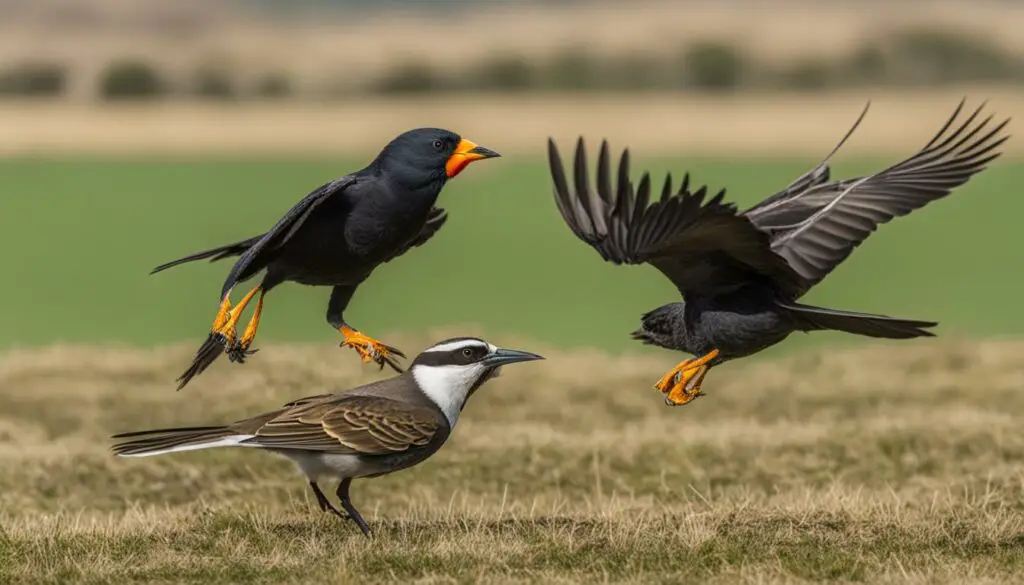
Conclusion
As I wrap up this article on bird flight training basics, I hope you have gained valuable insights and tips for successfully training your pet bird to fly outdoors. Remember, mastering basic training skills, establishing a strong bond, and gradually introducing flight exercises are essential components of a successful training journey.
Consistency and patience are key as you guide your bird through the training process. By incorporating positive reinforcement techniques and gradually increasing the complexity of exercises, you can help your bird develop the necessary flight skills and control.
Always prioritize safety during outdoor flights by providing appropriate supervision and using proper training equipment. Regular check-ups with a veterinarian will ensure your bird’s health and well-being throughout the training process.
With dedication and the right approach, you and your bird can enjoy the incredible experience of flight training. So go ahead, spread your wings and soar together!
FAQ
What age should I start flight training with my bird?
It is recommended to start flight training with a baby bird at the natural age of fledgling for faster and safer results.
Why is flight training beneficial for pet birds?
Flight training helps maintain their physical health, strengthens the bond between the bird and its owner, and stimulates the bird’s mental and cognitive abilities.
What are indoor flight training exercises?
Indoor flight training exercises involve gradually increasing the complexity and distance of flights within a controlled environment to develop the bird’s flight skills.
How can I create a comfortable outdoor flying area for my bird?
To create a comfortable outdoor flying area, you can place the bird’s cage in the intended outdoor area and allow it to become accustomed to the surroundings.
How important is bonding with the bird in flight training?
Establishing a strong bond with the bird is crucial for successful flight training as it promotes trust, cooperation, and a willingness to learn.
What should be included in a training routine for flight training?
A training routine should include allowing the bird to develop flight skills indoors, teaching flying back and forth to the trainer, getting the bird comfortable being outdoors, and developing a strong relationship.
What is target training and how does it help with flight training?
Target training involves teaching the bird to touch a target stick and helps develop precision, agility, and coordination, enhancing its flight skills and control.
How can I reinforce positive behaviors during flight training?
Reinforcing positive behaviors can be done through rewards such as food treats, praise, and favorite objects, creating an association between the desired behavior and the reward.
Why is socializing the bird important for flight training?
Socializing the bird exposes it to different environments and stimuli, helping it adapt and feel comfortable in various settings.
What is gradual conditioning and why is it necessary?
Gradual conditioning involves starting with short flights and gradually increasing the distance and duration to improve the bird’s physical condition and stamina.
How can I choose the right reinforcements for flight training?
Each bird has unique preferences, so it is important to experiment with different rewards to identify what motivates and reinforces positive behaviors.
What is recall flying and why is it important?
Recall flying is a skill that allows the bird to fly back to the trainer on cue, ensuring its safety and preventing it from getting lost during outdoor flights.
How can I develop fluency in flight training?
Developing fluency in flight training requires consistency, repetition of desired behaviors, and gradually increasing the complexity and difficulty of training exercises.
What safety considerations should I keep in mind during flight training?
Outdoor flights should be supervised, and proper training equipment can be used to provide additional security. Regular check-ups with a veterinarian are also recommended for the bird’s health and well-being.
Source Links
- https://be.chewy.com/pet-bird-flight-training/
- https://birdtricksstore.com/blogs/birdtricks-blog/indoor-flight-training-parrots-basics
- https://www.libertywings.com/basic-flight-training/


